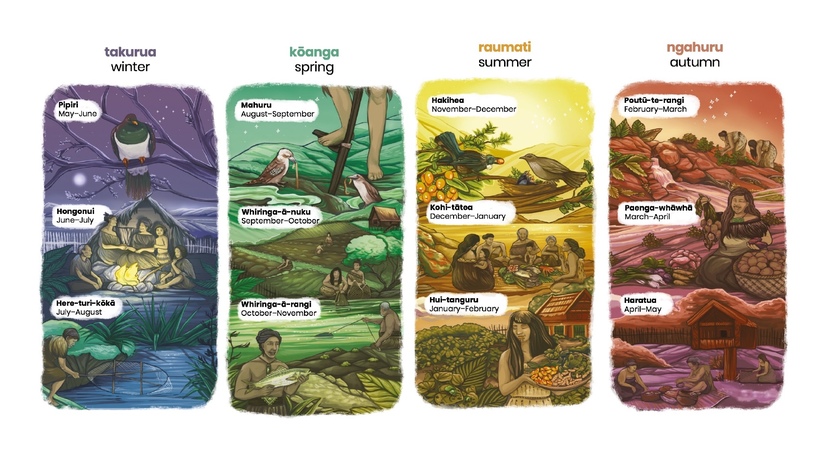Knowledge of tohu – biophysical indicators – has been passed down from tūpuna over many generations. From years of observation and tracking changes in the environment, Māori have developed an understanding of local environments and processes. Tohu are passed down through kōrero tuku iho, karakia, pūrākau, whakataukī and waiata. They allow access to the memories of tūpuna and can provide a snapshot of what te taiao looked like in the past.
Predicting weather patterns
Iwi have a range of tohu related to weather connected to their particular rohe, although many are shared across iwi. These indicators are used in combination to forecast weather for the upcoming day, month or season. Te Whānau-ā Apanui Tairāwhiti use the plume of Whakaari/White Island to predict rain or severe weather. In Te Wai Pounamu/South Island, Kāi Tahu use the presence of swarms of namunamu (sandflies) as one indication of rainfall.
Maramataka
One important method used by Māori for observing changes to te taiao is the maramataka, the Māori lunar calendar. The maramataka is a vast repository of mātauranga. It is also a predictive tool that follows the movements and phases of the Moon. For Māori, the maramataka is instrumental for deciding when to plant and harvest crops and indicating appropriate times to hunt and fish for specific animals. The maramataka helps to monitor and observe seasonal changes, weather and the migratory patterns of birds and fish as well as enabling rituals and other important matters to be tracked.
Local maramataka
There are many maramataka and tohu, and they vary from iwi to iwi. The appearance of the star Puanga or Rigel, for example, marks the start of Māori New Year in the far north, Taranaki, Whanganui, the South Island and the Chatham Islands. In Te Urewera, Ngāi Tūhoe know that cold weather and frosts in April are signs of a good year for kererū because the trees will produce plentiful fruit. The phases of the Moon are used by Māori to indicate the seasons of the year.
Another example of species used to predict climate patterns is tī kōuka or cabbage tree (Cordyline australis). Kāi Tahu use the flowering of these trees as a tohu, with early and profuse flowering indicating a long hot summer will follow.
Tohu and climate change
Today, Māori are observing many changes to te taiao. Because of a changing climate, some maramataka and tohu that have been used for hundreds of years can no longer be used in the same way. For example, changes in sea temperatures mean that kina are no longer fat and ready for the table when pōhutukawa traditionally bloom in summer. Gathering a feed of kina with whānau at Christmas time was once normal but is at risk of becoming a thing of the past.
Everything has its time … there’s time for fish, there was time for oysters, time for mussels. And it never altered until recently. I realised about two years ago things are changing. Things [plants] are blooming out of season. Fishing is all out of kilter. Mullet never came till winter and now you’ve got mullet coming any old time, sort of thing. It’s really changed.
Kaumātua, Muriwhenua (The Deep South National Science Challenge, 2018)
In the following waiata by Hirini Melbourne, Tāwhirimātea is asked specifically to stop the rain, clear the dark clouds and let the Sun shine. The waiata also contains a warning to the kōtare and noke (kingfisher and worm) about the consequences of failing to prepare and seek shelter. If we humans liken ourselves to kōtare and noke, the waiata can also be a warning to avoid the same failings.
Tihore mai te rangi – clear the sky
Tihore mai
Mao mao mao te ua – cease the rain
Whiti mai te ra – let the Sun shine
E rere kōtare – fly kingfisher
Ki runga pūwharawhara – onto the tree (astelia)
Ruru parirau – ruffle your wings
Kei mate i te ua – lest you catch a chill
E rere e noke – flee o worm
Mai to pokorua – out of your burrow
Kei ki i te wai – lest it be filled with water
Ka mate i te ua – and you will drown.
Related content
Explore further Māori insight – māramatanga Māori – related to climate and Earth systems and climate change and impact on biodiversity.
This resource contains kuputaka Māori mo āhuarangi hurihuri a hurihanga waro – reo Māori words associated with climate change and the carbon cycle.
Listening to the land is a Connected journal article describing the work of Dr Pauline Harris and others. Their research will help to increase understanding of how climate change is affecting the wildlife and ecosystems in Aotearoa – knowledge that can then be used to plan for change.
Discover waiata and whakataukī associated with the Waikato River.
Useful links
NIWA has a Traditional Māori Weather and Climate Forecasting (Ngā Tikanga Māori o te Tiro Huarere, me te Āhuarangi) poster, which shows a selection of traditional indicators used by Māori from across Aotearoa New Zealand to forecast weather and climate.
Dr Dan Hikuroa (Ngāti Maniapoto, Waikato-Tainui) is a senior lecturer at the University of Auckland who studies how to apply Māori knowledge to climate problems. When it comes to adapting to shifting climates, he says, indigenous knowledge can help all New Zealanders cope. Find out more in this Stuff news article.
See the 2021 report He huringa āhuarangi, he huringa ao: a changing climate, a changing world from Ngā Pae o te Māramatanga and Manaaki Whenua providing guidance for Te Ao Māori on climate change adaptation and mitigation.
Acknowledgement
This resource is based on Our Atmosphere and Climate 2020, produced by the Ministry for the Environment Manatū Mō Te Taiao and Stats NZ Tatauranga Aotearoa.



